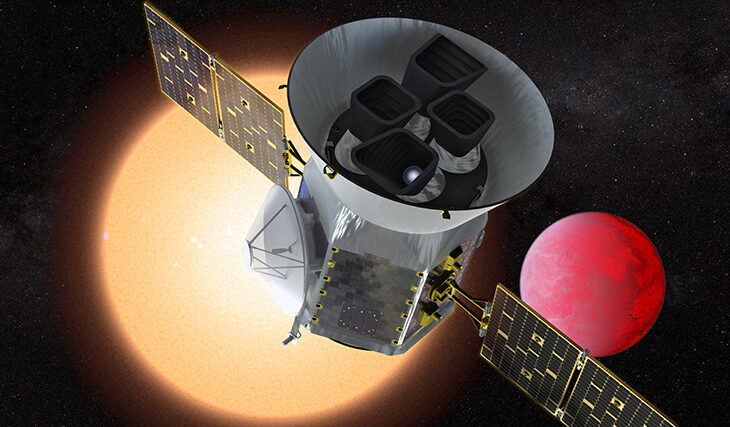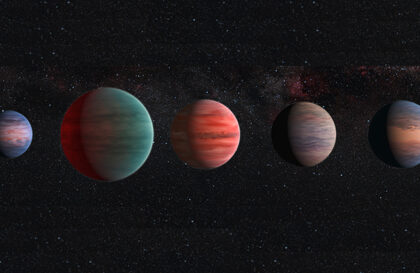The primary tool for searching for extrasolar planetary systems was the Kepler orbital telescope, which has an ultrasensitive photometer. Its only purpose is to search for planets around other stars. Kepler observed 530,506 stars and discovered 2,778 planets by June 16, 2023.
In 2018, the TESS (Transiting Exoplanet Survey Satellite) telescope was launched into low-Earth orbit. His task is to discover exoplanets using the transit method.
A successful example of detection is the planetary system of multiple exoplanets, HR 8799.
Another famous example is the exoplanet Fomalhaut b, orbiting the star Fomalhaut.
Also worth mentioning is Beta Pictoris b, an exoplanet orbiting the star Beta Pictoris. This planet is interesting because it has its own ring system or moons, analogous to Jupiter.
This method is most effective for detecting young, hot, and giant exoplanets far from their parent stars.
Planet Detection Methods
- Direct Imaging (Direct Observation Method).
Direct imaging of exoplanets is possible by capturing their emitted or reflected light. This method is effective for planets located between 10-100 astronomical units from their host star. Stellar coronagraphs, which block out the light from the star, make this method reliable.
A successful example of detection is the planetary system of multiple exoplanets, HR 8799.
Another famous example is the exoplanet Fomalhaut b, orbiting the star Fomalhaut.
Also worth mentioning is Beta Pictoris b, an exoplanet orbiting the star Beta Pictoris. This planet is interesting because it has its own ring system or moons, analogous to Jupiter.
A direct image of a multi-planet system around a Sun-like star. The planets, TYC 8998-760-1 b and c, are visible middle and lower right. Image credit: ESO/Bohn et al.
This method is most effective for detecting young, hot, and giant exoplanets that are far from their parent stars.
- Doppler Method
The Doppler Method is used to detect exoplanets by analyzing the fluctuations in the star’s radial velocity. This spectrometric method allows for discovering planets of various sizes, from a few Earth masses to gas giants, with orbital periods of up to 10 years. The Doppler effect helps determine whether the star is approaching or moving away from the observer.
A hidden exoplanet circling a far-off star induces the star to traverse an elliptical orbit. At certain times, the star approaches Earth (1), while at other times, it recedes from Earth (2). Owing to the Doppler effect, the star’s emitted spectral lines exhibit frequency shifts—blue-shifting when the star is coming toward Earth and red-shifting when it’s moving away. These frequency changes serve as clues to the existence of an exoplanet orbiting the star (Figure adapted from ESO).
Hundreds, if not thousands, of exoplanets have been discovered using this method. It is particularly effective for detecting giant planets close to their stars, such as “hot Jupiters.” Examples of planets discovered by this method include:
51 Pegasi b – one of the first discovered exoplanets, a “hot Jupiter,” found in 1995.
HD 209458 b is one of the first planets where direct atmospheric measurements were possible.
Gliese 581 c is one of the first potentially habitable exoplanets discovered in 2007.
Proxima Centauri b is a planet in the star system closest to the Sun, discovered in 2016.
Tau Boötis b is one of the first exoplanets discovered by the radial velocity method. Its discovery was confirmed through the transit method.
- Transit Photometry Method
The transit method is used to detect exoplanets by observing a decrease in the brightness of a star as a planet passes in front of it. This method is effective only for systems that are oriented towards the observer. If the ratio of the star’s and planet’s sizes is 10:1, the brightness will decrease by 1%. This method allows for determining the planet’s size and analyzing its atmosphere, but it requires multiple confirmations and long-term observation.
The transit method is one of the most successful methods for detecting exoplanets and has been employed by NASA’s Kepler and TESS (Transiting Exoplanet Survey Satellite) space telescopes. Thanks to the Kepler telescope, thousands of exoplanet candidates have been discovered, many of which have subsequently been confirmed using other methods and telescopes.
Kepler-22b, the TRAPPIST-1 system, and Kepler-186f are well-known examples of exoplanets discovered using the transit method. These planets have garnered particular attention due to their potentially habitable conditions or unique features, such as the possible presence of water or a life-supporting atmosphere.
- Timing Method
The method involves analyzing variations in the arrival time of periodic signals, which change due to the orbital motion of the source of these signals. This highly complex approach is used for detecting exoplanets orbiting around pulsars. If such a planet exists, the regular signals from the pulsar will exhibit characteristic fluctuations.
The discovery of exoplanets around pulsars is relatively rare. The most well-known example is the pulsar system PSR B1257+12. Three planets have been discovered orbiting this pulsar, making them some of the first exoplanets ever detected. These planets are often referred to as “pulsar planets” and were found in 1992 and 1994 by astronomer Aleksander Wolszczan.
These planets represent unique and interesting objects for study as they exist in extreme conditions, close to a high-energy pulsar.
- Gravitational Microlensing
When a star closer to us acts as a “lens,” amplifying the light from a star far behind it, this is called gravitational microlensing. If the nearer star has a planet, its gravitational influence can further distort this effect, thereby allowing the detection of an exoplanet. A limitation of the method is the need for precise alignment of the two stars and Earth along a single line of sight, as well as the short-term nature of the effect itself, which may last only a few days or weeks due to the constant motion of these objects. It is not possible to repeat observations with this method. Nevertheless, the method is successfully used for searching for planets between Earth and the center of our galaxy, where the concentration of “background” stars is high.
A sketch of a microlensing signature with a planet in the lens system. Image Credit: NASA / ESA / K. Sahu / STScI
The method allows for detecting planets with masses comparable to Earth’s. Currently, two projects dedicated to the search for exoplanets using microlensing are successfully operating: MOA (Microlensing Observations in Astrophysics) and OGLE (Optical Gravitational Lensing Experiment).
Using the microlensing method, the planet KMT-2020-BLG-0414Lb was discovered, which has a mass comparable to Earth—making it the most minor planet found using this method. The most distant planet from its star by this method is OGLE-2008-BLG-092Lb, situated at approximately 15 astronomical units. Meanwhile, the planet MOA-2015-BLG-337Lb is at the minimum distance from its star—just 0.24 a.u. It’s also worth noting that seven multi-planet systems have been identified using this method, each containing two planets.
To enhance the precision and completeness of the data, researchers often combine different observation methods. For example, both ground-based and space telescopes were used to study the TRAPPIST-1 planetary system. These instruments helped determine the planets’ sizes and revealed subtle gravitational interactions between the seven planets in the system. Based on this data, the mass of each planet was calculated.
Image credit:
https://physicsworld.com
https://kids.frontiersin.org
https://exoplanets.nasa.gov
https://britastro.org
https://www.universetoday.com






